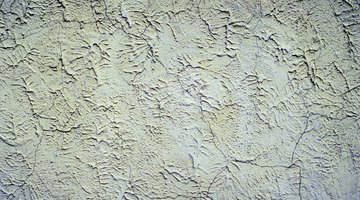Stomp Ceiling Techniques
Stomp ceiling textures use different brushes and tools to stamp a design into wet plaster. Once the plaster dries, it often receives a coat or two of flat latex paint.

Ceiling texture creates a sound barrier in rooms and reduces echo; the stomp texture in particular is useful for hiding any flaws in the drywall installation and requires a lower level of professional installation. Dings, seam and nail pops are quickly disguised with the layer of plaster.
Execution
Stomp ceiling techniques use a variety of brushes to create different textures. Round or oval bristle brushes can create an imprint in wet plaster; large plastic bags or crumpled-up plastic sheets pressed into the plaster also create interesting textures. The technique involves rolling plaster onto the ceiling and then pressing the chosen tool into the surface. Clean your tool often using water so the imprint is clean and does not contain excess wet plaster.
Material
One material commonly used to apply a stomp technique is joint compound. Artisans use joint compound because it is readily available in nearly all areas, and relatively inexpensive. Always mix the joint compound prior to beginning the project to ensure it is moist and has a smooth consistency.
Price
Surprisingly, a textured ceiling application often costs less and is less work than leaving a ceiling with a smooth finish. Creating a perfectly smooth, flawless finish on a ceiling is difficult and time-consuming, but a applying a stomp ceiling is fast and hides any installation flaws. This actually saves the homeowner or contractor both money and time.
Finishing
It's acceptable to leave the plaster unpainted once it is dry, but this finish attracts dust and is difficult to clean. Finishing a stomped plaster ceiling typically involves applying two coats of paint. The ceiling often immediately absorbs the first coat of paint; the second coat is the outer coating. Additional stains and color washes brushed over the plaster can create a distressed and antiqued ceiling finish.
References
- "Black and Decker Home Improvement 101; Everyday Care and Repair Made Easy"; Jerri Farris; 2005
Writer Bio
Julie Hampton has worked as a professional freelance writer since 1999 for various newspapers and websites including "The Florida Sun" and "Pensacola News Journal." She served in the U.S. Army as a combat medic and nurse for over six years and recently worked as the Community Relations Director for a health center. Hampton studied journalism and communications at the University of West Florida.
Photo Credits
- NA/AbleStock.com/Getty Images
- NA/AbleStock.com/Getty Images
More Articles



